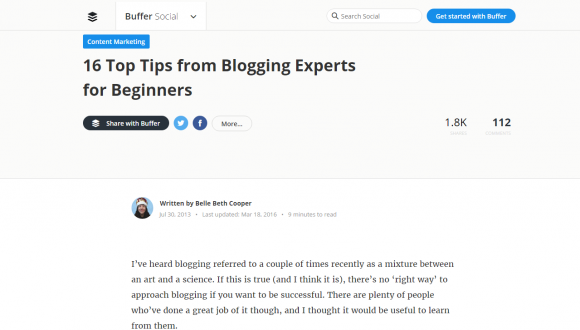When you’re setting up your marketing strategy, getting your brand out there is essential. Whether you’re climbing the ranks in a Google search or attracting new customers to your site, everything you do should push your brand to make it more popular and more visible. One way to encourage both new customers and better search rankings is getting links to your site from other sites. The type of link makes all the difference—but neither type is inherently bad. Though nofollow links have long been seen as less beneficial than dofollow links, that’s not a complete picture of the situation. Nofollow links come with their own set of benefits and offer real utility to anyone who wants to increase their SEO and promote their brand. [Read more…] about What Are The SEO Benefits of Nofollow Links?
Blog
How to Increase Your Organic Click Through-Rates
One of the most important aspects of marketing your online business is reaching out and grabbing the attention of new customers. While you can get website visitors from other sources, choosing to focus on your website ranking and search engine position may yield the best results in terms of boosting your visibility. One important metric to consider is your organic click through rate (CTR). Boosting your organic click through rate means getting more people on your website and positioned to buy your products or services.
What is Your Organic Click Through Rate?
A click through rate (CTR) is simply the number of people who click on a link that goes to your website. There are a lot of different ways to get clicks, including advertising or social media posts. What makes a particular click organic is that it doesn’t rise from advertisements. It’s a direct click from a search where you appear because of your SEO, not your advertising budget. The number of people who click on your website in search results is your organic click through rate.

Items above the fold on Google–and items that rank higher in the search–see more clicks than others. One factor in your search result placement is how many people click on your search listing. In the screenshot above, there are many factors at play that determine which result comes first. One is the organic click through rate. Since the first Google search result gets 33 percent of the traffic, anything that improves your position can help increase your business.
Why is Your Organic Click Through Rate Important?
Your organic click through rate gives you a metric for judging how well your keywords, titles, and meta data are doing, and whether you need to adjust them to draw more website viewers in. The less clicks your search listing gets compared to other listings, the more you’ll fall in rank. The higher your rank, the more likely your link is to get clicked on by a person who has searched for a particular keyword or phrase.
You can increase your organic click through rate by making adjustments on various aspects of your Web content. Updating past content so that it matches best practices for better organic click through rates and tailoring future content with an eye toward getting more clicks can improve the amount of traffic your website gets. Another benefit to boosting your organic click through rate is that you may see a rise in your search engine positioning. The more people who click on your link, the better you do against competitors fighting to get clicks for the same terms you’re targeting.
There is also very strong evidence that click through data is taken as a ranking signal by Google.
Next time I hear a Googler say “we don’t use query/click data in rankings,” I’m pointing to https://t.co/qETZpGEbm9 pic.twitter.com/m9DO3cBVXb
— Rand Fishkin (@randfish) March 17, 2016
Long Versus Short Tailed Search Terms
If most of your targeted keywords are short one or two word terms, think longer to see an increased click through rate.
A study by Search Engine Watch found that:
“In general, we see a steady and almost monotonic increase in CTR, conversion rate, and conversions per 1,000 impressions as keywords increase in length, with the most “efficient” keywords in the 31-35 character bucket. Note that keywords above 40 characters not only generated a tiny number of impressions – they also weren’t terribly efficient.”
So when you’re setting up your keywords and targeting search terms with an eye toward getting more traffic, try to think of longer phrases that you want to target. If you can hit that terms length of 31-35 characters, even better.
Adjusting Your Titles
One of the first things a searcher sees when performing a search is the title of the page. There are two things to focus on when choosing a title.
First, make sure it’s relevant to your content. If a title isn’t relevant and doesn’t properly represent the page, even a well-targeted link may not get a click when a searcher chooses to click another, more pertinent link. Catchy titles that don’t give information about the page or misrepresent it can lead to low clicks or low rates of return visitors.
The second thing to think about is whether the title is dry or appealing. People are more likely to click on titles that tug at their heartstrings, stimulate their interest or seem to offer more utility. Before you title a page, consider whether someone glancing at it will feel a strong desire to click based on the terms you’re targeting. If you think it’s bland or unappealing, try a different title.
When developing a title, try to work in the format of the piece, a power word, the type of content and your subject. All of these together will make an interesting title that will draw in more clicks. For example “Eight Shocking Questions to Ask at Job Interviews” is better than “Job Interview Questions to Ask”.
Search Engine Journal recommends writing titles from different perspectives, depending on which best matches your content. They suggest:
- The Feel Good Friend
- The Comedian
- The Hero or Villain
- The Bearer of Bad News
Keep in mind that a change in punctuation or capitalization doesn’t create a new title, just a version of the old one that looks different. Use new words and get an entirely new take on the title instead.
Go back to old content and review your titles. It’s a good idea to use targeted search terms in your titles, but that shouldn’t be the end of it. An appealing title that offers utility will draw in a searcher more quickly than just a keyword set. For example, “Children’s Books” is a possible search term that could function as a title. “Ten Children’s Books That Will Inspire You” is more emotional and likely to generate clicks.

13 Ways to Increase Your Organic Click Through Rate
- Examine your current click through rate for each page and site you have. List the difference between the highest-performing pages and the lowest performing pages. Once you can clearly see the things that draw in visitors, you can adjust your content strategy to develop more content that encourages people to click on your site rather than a competitor site.
- Adjust your content to include lists and mention the list in the title. Searchers tend to click lists when offered headlines in a set of links both with and without lists. Most topics can be adjusted to include some type of list that works with your content.
- Use power words: words that evoke an emotional response. Think adjectives. “25 Delicious Pizzas to Try in Chicago” is more powerful than “Chicago Pizza”.
- Make custom URLs. When you use descriptive words rather than random numbers and letters in your URL, people are more likely to click it.
- Don’t worry about pushing your brand in the title of the page. It will be on your website, and may appear in the description of the site or the URL. Use the valuable character space you have to push the title that increases your organic click through rate. The only exception to this is if you’re a known industry leader already or are trying to rank for your brand name specifically.
- Reference the volume of what you’re offering. Don’t just say that you can recommend some hotels in a specific city. Instead, say the exact number. People respond to titles and descriptions that include actual numbers.

- Work in punchy facts, where appropriate in the title or description. A short fact worked into your search result may draw attention and clicks. For example: “22% of High School Seniors Don’t Write Passing Essays—We Can Help You Get Into Your Dream College.”
- If you have a special offer, giveaway or some kind of promotion, mention it in the title. Many people will never read past a title, so leading with your best foot forward can help pull a skimmer in.
- Focus in. If you have a site that’s designed to lead tourists to the best places in town, a page about Italian restaurants and museums isn’t as targeted and many people will skip it in favor of something more specific. You can always add additional pages to your site, and link from one article to another.
- When writing your page description, try to answer a question or offer something to the reader. This gives a searcher an early idea of how your page is useful. The more useful your listing appears, the more likely someone is to click on it.
- End all website meta descriptions with a call to action. When a reader finishes reading what you have to offer—whether it’s a product, a recommendation or information—use the call to action to encourage them to take the final step and click.
- Create more content. The more pages you have, the more searches you’re able to appear in. There are only so many keywords or phrases you can target with any given page of content; by increasing your content, you’re increasing your reach.
- Use rich snippets to draw a searcher’s attention to your listing. Rich snippets are a type of data markup that is included in your Google search listing. Once you’ve adjusted your listing to include them, it may show a star rating, a price or other information from your page, which can help distinguish your page in a list of results.

Testing Your CTR Strategy
Once you’ve developed a strategy to get higher click through rates, test it. Since there are many different approaches to combine, which ones work for you will depend on your brand, site and audience. Try a few different strategies with similar pieces of content at once to see which draws in more clicks and repeat viewers.
Once you’ve narrowed down the types of changes that work best for you, remember to go back and adjust your older content. Make sure every piece conforms to your new approach for a higher click through rate, which will increase overall traffic to your site, especially if you’re focused on evergreen content.
Don’t stop testing just because you find a strategy that works. Web marketing is a changeable field and what works today may not yield results tomorrow. More importantly, you may come across a new idea, test it, and find that it produces an even higher conversion rate. If you play around with your old content, it also has the benefit of updating the page—which is a positive signal to your Google ranking. So don’t be afraid to keep testing as you continue to grow your business.
Even when you’re trying to boost your organic click through rates, there’s no harm in testing with a paid ad, which may give you more data. Test the same ad with a few different headlines, determine which one performs the highest for conversions, and then use that headline as the title of the page you’re creating. You can use what you learn from that test to title future pages, too.
At the same time, Larry Kim of Moz says that you shouldn’t change your title every week on a particular page, because Google will think it’s being “dynamically populated.” The same applies to every type of content. Try new things, but don’t go overboard. Choose a few pages for testing–not your entire site.

Increasing your organic click through rates by improving your search result appearance, offering answers to questions and distinguishing your listing will expose your brand to more people. It’s also beneficial to optimize past content so that you have more listings appearing for more search terms. As you implement and test different ways to increase your organic click through rate, you’ll also be building your customer base and brand—so keep tweaking your site until you have the results you want. Your site will draw more viewers as you optimize your listings and increase the utility of your search results.

How to Create Evergreen Content to Grow Your Brand
Posting evergreen content to your website ensures you have a number of articles that don’t fade in utility over time. Unlike information that will become irrelevant as things in the industry change from day to day, evergreen content will stand the test of time and offer benefits to both your ability to find new website viewers and your position as an expert in your field.
What is Evergreen Content?
What makes a piece of content evergreen is that it’s as relevant next year as it was last year. It’s timeless. Instead of being a flash in the pan that quickly generates views and then stops getting hits when new, updated information becomes available, it sticks. Evergreen content deals with topics that aren’t constantly changing. If you post a piece of evergreen content today, it could still draw in clicks from a search engine in five years.
When you post a piece of time-sensitive content, it may ramp up your website visitor count for a few days or weeks, and then fade away. As the information becomes less relevant, it will decrease the amount of clicks a piece can get. While time-sensitive content does help get people to your page, evergreen content will be able to generate a higher volume of clicks in the long-term simply because people will still see and respond to it as time goes by.
Examples of Evergreen Content
If you haven’t developed pieces with evergreen content in mind before, here are a few examples that can help get you started.
Instructional guides.
– Even product guides for products that are older will stay evergreen as long as people continue to use the old model.
Getting Started
– People will always need an entry-level approach into your topic. Try keeping it basic and your piece will stay relevant in the long term.
Case Studies
– If you do original research, pair your results with an explanation of how you got them to offer new information that will stand the test of time.
Neil Patel’s excellent case study on writing case studies, very meta!
Definitions
– The definitions for words rarely change. When someone searches for a word, your website may be the result they choose on Google. Going into depth about a term and its history may offer even more utility.
Lists
– Lists of unchanging information offer both an attractive format and evergreen content.
Bufferapp’s blogging tips post is 4 years old and still being updated!
Interviews with industry experts
– Connect with thought leaders in your field and ask if they’d be interested in an interview via email or Skype, many people will welcome the exposure!
Historical topics or encyclopedic entries
– Since history doesn’t change quickly—even while some industries create new history every day—a page offering historical or encyclopedia content can offer utility for years to come.
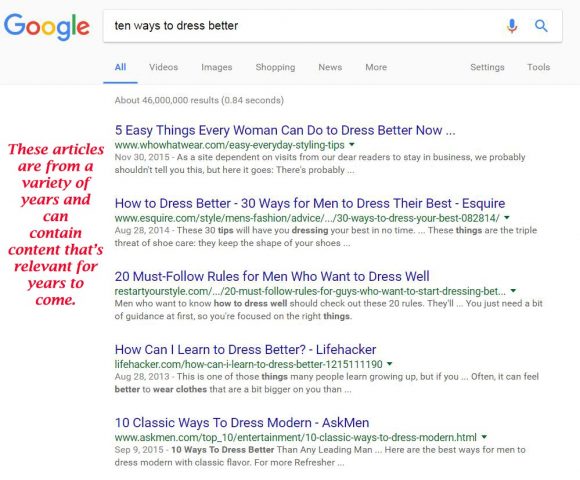
What Evergreen Content Isn’t
Many types of content aren’t evergreen and that’s okay—sometimes it’s necessary to publish stories that will get a high volume of hits in a short time. Time-sensitive content has its place and offers a different kind of benefit, but shouldn’t be the only thing you publish. Types of content that aren’t evergreen include:
News stories
– News stories are one of the most common content types that are time-sensitive, not evergreen.
Seasonal articles
– Though they may be relevant each Christmas or fall, for example, they won’t generate clicks all year and will die off almost completely when the holiday or season isn’t taking place.
Trends articles
– Since trends change every year, discussing them is always time-sensitive. The nature of trends also means that old ones quickly become irrelevant and are replaced with new, current ones.
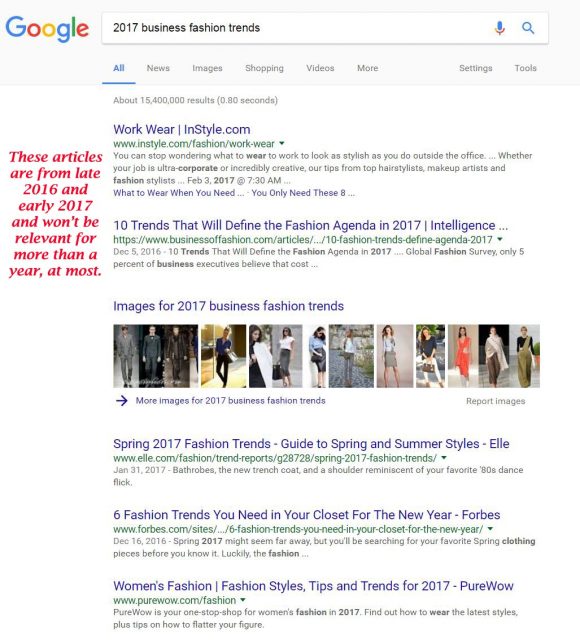
How to Reach Your Target Audience With Evergreen Content
The best way to reach everyone is to post a mix of evergreen content and time-sensitive content. However, unless your site is focused on providing up-to-date information and being on the cutting-edge of a topic, it’s better to focus on evergreen content. As you build a library filled with evergreen content, you’re also building up a series of links and webpages that help draw people to your site. Every new piece of content you offer is another link in the chain that brings new viewers in and helps grow your business.
Another way evergreen content can help grow your business is by generating social shares. The more relevant something stays over time, the more likely it is that a person will share it on their social media profiles, connecting your business to their friends, relatives and business associates. So instead of pulling in a bunch of views at once that quickly dissipate, you can get organic clicks through quality content that encourages shares.
If you update your site five times per month, try to make sure at least four of the five updates are evergreen content. The last one can be a piece of time-sensitive content that draws in viewers interested in something trending quickly and helps give your site a temporary boost in traffic.
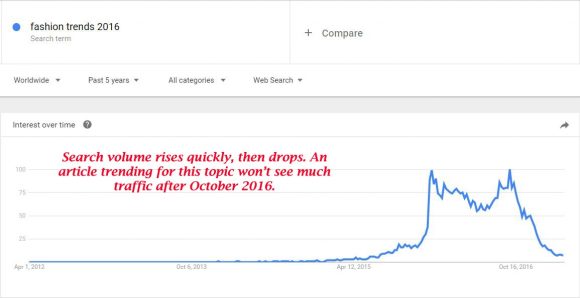
Examples of time sensitive vs evergreen content
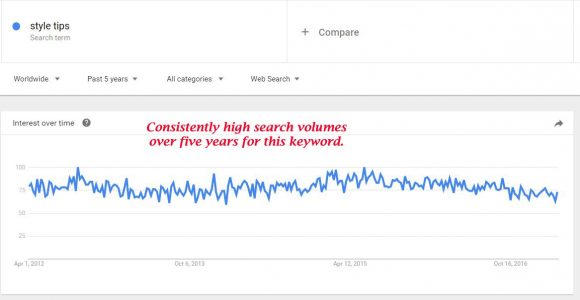
How Evergreen Content Affects SEO
Publishing evergreen content can affect your search ranking, which has a direct effect on how many people visit your website. According to Search Engine Watch, sites that focus on evergreen content get more clicks on pages that offer evergreen content. Those pages are the most popular. Similar sites that focus on time-sensitive content are more likely to get clicks on their homepage and other static pages, rather than time-sensitive articles. In other words, evergreen content draws more clicks than time-sensitive articles in many cases.
The same post also explained that, of the two sites they compared, the one that focused on evergreen content got more recurring traffic from their articles and has greater search visibility in similar topics. So if you’re looking to grow your audience and your business, focusing on evergreen content can boost your search rankings for the terms you want to target.
When Harsh Agrawal added dates back to his evergreen content his traffic dropped by almost 40%.
The Effect of Date Stamps on Blog Traffic [Case Study]
Evergreen Content and Keywords
One aspect of SEO that evergreen content affects is keywords. Choose good keywords and phrases that will drive traffic to your site, and then use them in your content. Doing so will help your site rise in the search results until it’s more visible to searchers.
For example, targeting a term like “wooden furniture repair” may be hard to rank for at first because there are millions of results on Google. However, as you generate more evergreen content, search engine crawlers are going to pick up more from your page. When you write evergreen pieces that use the keywords you’re trying to rank for, and those words are picked up by the search engine crawlers, you’re going to get boosted in rank for that term.
The pages those keywords exist on give you a better boost in search results if they’re not out-of-date and if they have more traffic. Since evergreen content produces more views over time, it will be favored over time-sensitive content when being indexed by Google and other search engines. This means that pages that use your keywords and feature evergreen content are more likely to be visible to customers who search for those keywords over time.
Evergreen Content and Brand Authority
Evergreen content also offers the benefits of giving you brand authority. Brand authority shows that you’re an expert in the area of your business and offers them confidence in trusting that you can provide the best possible product or service.
One way to both gather evergreen content prompts and increase your brand authority is to take questions from customers on your social media profiles. Answer the questions in a frequently asked questions page or on its own page, if warranted, and then you have new evergreen content that someone could perform a Google search to find.
A great piece of evergreen content on lawn care by Lawnstarter.com
Another strategy is to publish interviews with experts or people well known in your field. Not only will it give you a new set of keywords, but it will show that you’re plugged into your industry and knowledgeable in the field. Interesting interviews also serve as another type of evergreen content.
As always, the most important way to offer utility and increase your brand authority is to offer well-written, honest and high-quality information in your evergreen content.
Ways to Get Creative with Evergreen Content
Not all evergreen content has to be writing. One way to increase the effectiveness of an instructional video, for example, is to illustrate the process of something hands-on with a video or pictorial. You can make a mix of content types before posting in order to give your audience the best return for their click and also to keep them coming back to you for more information on other topics.
Try making a question and answer series to generate some fresh evergreen content. Other people may be searching for the same questions other viewers have, and answering those questions on your site will draw those people to click on it. As long as the answers aren’t dealing with news topics or trends, the question-and-answer format is an easy way to post solid evergreen content.
Another way to get creative is to use interactive content. 75 percent of respondents agreed that interactive content can “provide a ‘sample’ of the brand, resulting in a higher degree of lead nurturing,” according to a survey by the Content Marketing Institute. This means that you can use interactive, evergreen content as part of a long-term strategy to grow your business by introducing your brand to new customers.
Concerthotels.com put together this very impressive piece of interactive content that looks at vocal ranges of pop stars
Checklist for Evergreen Content
Before you publish your content, ask yourself these questions to make sure it’s evergreen:
- Will this still be relevant to a viewer in one year? Two years? Five?
The longer it will be relevant, the more evergreen it is. - Does this deal with a topic that will fade in importance over time?
Topics like family, technology, relationships, education and healthcare may change, but the fundamentals stay the same. They’re always important and people will always be looking for content on those topics. - Who am I writing for?
Since experts may not need basic evergreen content as much as beginners in a topic, write for a wider base of people. While it’s fine to write to the group interested in your niche business, you’re less likely to get clicks if the content isn’t accessible by a person searching for your keywords. - Is this topic already covered?
Often, it feels like topics have already been done. Don’t let that deter you from making similar content, because you can put your own spin on it and offer new utility. Whether it’s the content itself, the accompanying images or your own specific authority on the topic, don’t let the fear of repetition stop you. - Is there a way to make this more niche?
- Another way to ensure your content offers new utility is to delve into a niche that isn’t as covered. If you are in a very specific field, it will be easier to generate evergreen content that doesn’t feel repetitive.
- Is there a way to make this more relevant in the long-term? Can I add media that makes it more useful to viewers?
Tips For Publishing Evergreen Content
Before hitting publish on your article, check to see whether it connects to other articles on your site. If it does, include links from that article to another one. It will help your search engine ranking and lead visitors to other areas of your site and new topics they might not have considered.
Update pieces as necessary to keep them evergreen. If you’ve written something about the history of a specific type of technology, you can go back and add a new bullet to your timeline in just a few minutes. Doing so will keep the page relevant and offer better, more complete information to visitors. The more complete your coverage of a topic, the better your expertise will appear to viewers. This can help grow your business by giving a customer confidence in your products and services.
Ultimately, publishing evergreen content will help build your business by drawing in new viewers and making your site into an authority on its topic. Over time, evergreen content will build up until you have a series of links and pages that draw in new customers and get your offerings in front of them. While there is a place for time-sensitive content, a marketing strategy that focuses on evergreen content should deliver better results in the long-term.
Should We Give In To Clickbait When Creating Content?

Best SEO Practices for Website Security
Google first indicated that they’d start prioritizing sites with valid security certificates years ago, and soon after rolled out with a significant ranking boost to sites that offered HTTPS certificates. Many sites are still using the older, less secure HTTP protocol and losing out on a valuable way to improve SEO and reach more visitors. Just creating an HTTPS site isn’t as effective, though. Use the best practices to choose your security certificate, set up and roll out your site to get the largest possible boost from the change. [Read more…] about Best SEO Practices for Website Security
Metadata SEO Best Practices
Metadata is information about a webpage that doesn’t appear on the page itself, but instead is part of the code that makes the website. For example, the page description in the metadata may not appear on the page itself, but will appear on search engine previews and, depending on your site’s code, along with the post when it’s shared on social media or through email. The right metadata can influence your click-through rate and help improve your site’s visibility by improving your content and engagement. [Read more…] about Metadata SEO Best Practices
Posting the Right Amount of Content for Engagement
Engaging with an audience is one of the most important aspects of marketing your product or service on the Web. One major way to reach people is with updated content that you share on social media, including articles, blog posts and new Webpages. However, it’s possible to push out too much content and fatigue your audience or oversaturate their feeds. While there is a clear benefit to posting new content regularly, finding the right amount and times is an essential part of any marketing strategy. [Read more…] about Posting the Right Amount of Content for Engagement
How To Use Giveaways to Boost Your Followers & Grow Your Social Audience
70 percent of respondents to a Pew Research Center study said they check Facebook at least once per day. If you’re using social media to connect with consumers, the more followers you have, the better. One way to get more followers for your business is to run and promote a giveaway. By providing a free product or service to people who follows your blog, social media profiles, or newsletter, you’ll attract customers who haven’t yet signed up to learn more what you’re promoting. The most important part of giveaways is making sure they’re attractive to the right set of people and that they get in front of the people who you want to sign up. [Read more…] about How To Use Giveaways to Boost Your Followers & Grow Your Social Audience
Getting Ahead of SEO Algorithm Tweaks By Offering a Better User Experience
Instead of waiting for a new SEO change to take effect, get ahead of the curve by offering a better user experience now. A focus on improving certain aspects of your site will ensure that you don’t drop down in the search results when new changes are rolled out, which means that you’ll still be visible to the people you want to reach. Waiting until changes are implemented will put you behind—and improving your Web presence now has the added benefit of creating a more relevant, attractive and secure website. [Read more…] about Getting Ahead of SEO Algorithm Tweaks By Offering a Better User Experience


